| Tabanan
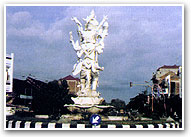 The regency of
Tabanan in the west has a turbulent history not unlike that of
its neighbors. According to rather hazy accounts, the first
Raja of Tabanan, Arya Damar, was appointed by the fallen
Majapahit Emperor, who assigned him an extensive kingdom
consisting of a large amounts of the lands to the south,
Tabanan and Mengwi, in appreciation of his valiant services in
subduing the island of Bali. The regency of
Tabanan in the west has a turbulent history not unlike that of
its neighbors. According to rather hazy accounts, the first
Raja of Tabanan, Arya Damar, was appointed by the fallen
Majapahit Emperor, who assigned him an extensive kingdom
consisting of a large amounts of the lands to the south,
Tabanan and Mengwi, in appreciation of his valiant services in
subduing the island of Bali.
As the generations went by the warring
descendants of this Raja divided the kingdoms and Mengwi was
split between Tabanan and Badung in the 17th
century.
The death of Raja Ngurah Agung, and
consequent cremation in 1903, brought an unexpected turn of
events, His cremation, to which the royalty of all other
kingdoms were invite, was carried out with traditional "Sutte"
rites, the last recorded in Bali, in which the wives of the
late Raja followed their husband in death by jumping into the
funeral pyre, causing outrage amongst the Dutch.
This was followed by another incident, the
plundering of the shipwreck Sri Kumala, in which both men from
Tabanan and Badung were implicated. Dutch forces intent on
punishment marched on Badung, and a terrible "puputan"
resulted. Subsequently they attacked Tabanan, where the Raja
and his prince decided to bargain with the Dutch. They were
threatened with exile, and put in the Denpasar jail, where
both finally committed suicide. Their closest relatives were
exiled to Lombok, and the magnificent palace of Tabanan was
plundered and razed by the Dutch army.
The Royal Lands, which covered one of the
richest rice-growing areas in Bali, were redistributed amongst
councils of individual villages, and the regency of Tabanan
prospered in general.
From the Mountains
to the Sea
From Mount Batukau, Bali’s second highest
mountain, covered in dense tropical jungle, the regency
stretches in a sweeping panorama of fertile rice fields to a
vast expanse of coastline, rocky outcrops interspersed with
long sandy beaches.
Pura Luhur
Batukau
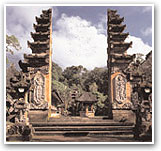 In dense jungle near the
peak of Batukau, at the end of a narrow winding road, lies the
ancient mountain sanctuary of the Rajas of Tabanan, Pura Luhur
Batukau. Here mythical tigers roam the forest, appearing each
year in their spirit form during a trance dance of the temple
festival. The ancient temple complex has a number of separate
sanctuaries joined by damp mountain paths , a bubbling spring
and a large rectangular lake with another shrine in its midst.
In the main temple is a single seven-tiered meru to Mahadewa,
the deity associated with Batukau, as well as shrines of the
three mountain lakes, Bratan, Buyan, and Tamblingan. Built as
the state temple of the Kingdom of Tabanan, and ancestral
temple of its royal family, it has the distinctive stone
shrines or "parasada" of all those temples closely linked with
Majapahit influences. In dense jungle near the
peak of Batukau, at the end of a narrow winding road, lies the
ancient mountain sanctuary of the Rajas of Tabanan, Pura Luhur
Batukau. Here mythical tigers roam the forest, appearing each
year in their spirit form during a trance dance of the temple
festival. The ancient temple complex has a number of separate
sanctuaries joined by damp mountain paths , a bubbling spring
and a large rectangular lake with another shrine in its midst.
In the main temple is a single seven-tiered meru to Mahadewa,
the deity associated with Batukau, as well as shrines of the
three mountain lakes, Bratan, Buyan, and Tamblingan. Built as
the state temple of the Kingdom of Tabanan, and ancestral
temple of its royal family, it has the distinctive stone
shrines or "parasada" of all those temples closely linked with
Majapahit influences.
Tabanan
City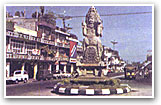
The capital of the regency is a bustling,
growing town, with a long main street dominated by shops and
tiny restaurants. There is a large central produce market and
which appears as if by magic in the evening, filling up an
empty street, and is literally rolled away before
down.
Kerambitan
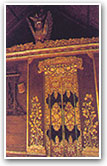 Once a minor court
attached to the Royal family of Tabanan, the village of
Kerambitan, just a few kilometers off the main road to the
southwest, has two rambling Puri palace complexes. In elegant
architectural style, pavilions are laid out in a series of
spacious courtyards according to they traditional function.
Here regular performances of the Tektekan are held, a stunning
creation which derives from the Calon Arang drama of exorcism,
complete with realistic trance and fear some
kris-stabbing. Once a minor court
attached to the Royal family of Tabanan, the village of
Kerambitan, just a few kilometers off the main road to the
southwest, has two rambling Puri palace complexes. In elegant
architectural style, pavilions are laid out in a series of
spacious courtyards according to they traditional function.
Here regular performances of the Tektekan are held, a stunning
creation which derives from the Calon Arang drama of exorcism,
complete with realistic trance and fear some
kris-stabbing.
Tanah
Lot
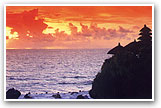 A trip in the
Tabanan Regency is not complete without a visit to the ancient
temple of Tanah Lot. From Kediri the narrow road meanders
trough verdant rice fields and quaint little villages to this
picturesque sea temple which is perched upon a rocky outcrop
surrounded by crashing surf at high tide. Attributed to the
influence of the 16th century priest Dang Hyang Nirartha, this
rugged rock has been eroded over the centuries by the swirling
tides, and the government plans a formidable restoration
project in the near future to prevent further damage. Tanah
Lot is one of Bali’s six most important temples that are
closely related to a number of equivalent mountain
sanctuaries. A trip in the
Tabanan Regency is not complete without a visit to the ancient
temple of Tanah Lot. From Kediri the narrow road meanders
trough verdant rice fields and quaint little villages to this
picturesque sea temple which is perched upon a rocky outcrop
surrounded by crashing surf at high tide. Attributed to the
influence of the 16th century priest Dang Hyang Nirartha, this
rugged rock has been eroded over the centuries by the swirling
tides, and the government plans a formidable restoration
project in the near future to prevent further damage. Tanah
Lot is one of Bali’s six most important temples that are
closely related to a number of equivalent mountain
sanctuaries.
Pejaten
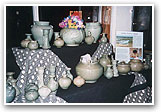 A tradition of
earthenware pottery-making has for centuries kept the villages
of Pejaten busy making useful pots, tiles and ornaments from
fire-baked clay. The fragility of the pots ensures both
continual supply and demand, and they are used all over the
island. In the last few years a foreign aid project within the
village has set up a new sophisticated kiln and fully equipped
studio where the youth of the village are trained in the
application of glazes, opening up a complete new market in
durable kiln-fired ceramic ware. A tradition of
earthenware pottery-making has for centuries kept the villages
of Pejaten busy making useful pots, tiles and ornaments from
fire-baked clay. The fragility of the pots ensures both
continual supply and demand, and they are used all over the
island. In the last few years a foreign aid project within the
village has set up a new sophisticated kiln and fully equipped
studio where the youth of the village are trained in the
application of glazes, opening up a complete new market in
durable kiln-fired ceramic ware.
Alas
Kedaton
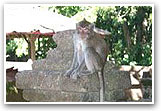 Alas Kedaton or
"Holy Forest" is a small forest measuring about 12 hectare. On
this forest is an old temple and to the south east of the
temple is a small field called the monkey cemetery but so far
the truth of the story has never been confirmed. There are
hundreds of monkeys in this forest and high up on the big
trees many bats are hanging and singing with their loud
voices. Alas Kedaton or
"Holy Forest" is a small forest measuring about 12 hectare. On
this forest is an old temple and to the south east of the
temple is a small field called the monkey cemetery but so far
the truth of the story has never been confirmed. There are
hundreds of monkeys in this forest and high up on the big
trees many bats are hanging and singing with their loud
voices.
Marga
 The Battle of Marga (Margarana), on 20 November
1946, goes down in the annals of Balinese history as the most
valiant struggle against the Dutch during Bali’s many years of
fighting for independence. The Hero of the occasion, Lt.Col. I
Gusti Ngurah Rai, and his band of 94 Balinese fighters were
killed to a man, after exhibiting brave resilience under
bombardment from the air, surrounded by a Dutch force superior
in both weaponry and numbers. A tall monument to this battle
stands in quiet field at the village of Marga, a famous letter
by Ngurah Rai, refusing to surrender unto death, inscribed
upon it. Rows of stone date memorials to the soldiers lost in
the battle field, and each year on the same date a memorial
march and service are held there. The Battle of Marga (Margarana), on 20 November
1946, goes down in the annals of Balinese history as the most
valiant struggle against the Dutch during Bali’s many years of
fighting for independence. The Hero of the occasion, Lt.Col. I
Gusti Ngurah Rai, and his band of 94 Balinese fighters were
killed to a man, after exhibiting brave resilience under
bombardment from the air, surrounded by a Dutch force superior
in both weaponry and numbers. A tall monument to this battle
stands in quiet field at the village of Marga, a famous letter
by Ngurah Rai, refusing to surrender unto death, inscribed
upon it. Rows of stone date memorials to the soldiers lost in
the battle field, and each year on the same date a memorial
march and service are held there.
Bedugul
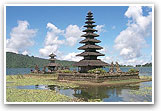 The road
through central Bali over to the north coast reaches its
highest point at the mountain resort of Bedugul. Suddenly the
view opens up of sparkling Lake Bratan, lying serenely in the
midst of an elongated valley which was formed centuries ago,
crater of some primeval eruption. Forest clad hills back the
lake, and on one shore is a tiny boating resort, with canoes
and speed boats available for trips on the lake. Perfect
water-skiing conditions prevail here all year
round. The road
through central Bali over to the north coast reaches its
highest point at the mountain resort of Bedugul. Suddenly the
view opens up of sparkling Lake Bratan, lying serenely in the
midst of an elongated valley which was formed centuries ago,
crater of some primeval eruption. Forest clad hills back the
lake, and on one shore is a tiny boating resort, with canoes
and speed boats available for trips on the lake. Perfect
water-skiing conditions prevail here all year
round.
There are flowers, fruits and vegetables
market at the southwestern corner of the valley, where
day-trippers generally stop and stock up on mountain-fresh
supplies, flowers and plants for their gardens. The road veers
off here towards the western foothills, where an entire
tree-clad hillside is laid out in Botanical Gardens with a
special orchid plantation.
|

